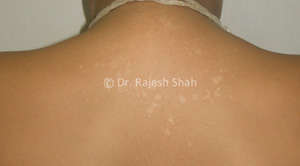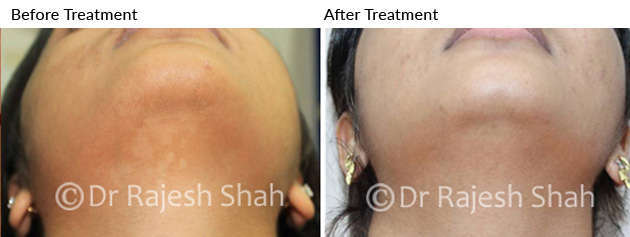Tinea Versicolor Treatment with Homeopathic Medicine
Tinea (pityriasis) versicolor is a chronic fungal (yeast) infection of the skin mainly which is observed in children as well as in adults. This condition is commonly observed in people, especially in tropical and subtropical countries such as India. It tends to stay on for many months or even years, as fungus tends to be resistant to many treatments.
Causes Tinea Versicolor:

It is caused by the overgrowth of a type of yeast called Malassezia, which is naturally found on the skin. Under certain conditions, this yeast can multiply excessively and lead to the development of tinea versicolor. The initiation of this condition is influenced by various factors, including:
1) Malassezia Yeast: The fungus Malassezia is a normal part of the skin flora. However, in some individuals, it can overgrow and disrupt the normal balance of microorganisms on the skin.
2) Warm and Humid Conditions: Malassezia thrives in warm and humid environments. Tinea versicolor is more common in regions with hot and humid climates.
3) Oily Skin: The yeast feeds on the oils produced by the skin's sebaceous glands. Individuals with oily skin may be more prone to tinea versicolor.
4) Hormonal Changes: Hormonal fluctuations, such as those that occur during adolescence, pregnancy, or while taking oral contraceptives, can increase the risk of developing tinea versicolor.
5) Sweating: Excessive sweating, especially in areas where skin rubs against skin, can create an environment conducive to the growth of Malassezia.
6) Weakened Immune System: Individuals with compromised immune systems, such as those with HIV/AIDS or undergoing immunosuppressive therapy, may be more susceptible to fungal infections, including tinea versicolor.
7) Certain Medications: Prolonged use of corticosteroids or immunosuppressive medications can contribute to an increased risk of fungal infections.
8) Genetic Predisposition: Some people may have a genetic predisposition that makes them more susceptible to tinea versicolor.
Symptoms of Tinea Versicolor:
The condition commonly presents with distinctive symptoms, which can include:
1) Skin Discoloration:
The most noticeable symptom is the presence of discoloured patches on the skin.
The colour of patches may vary, appearing either lighter or darker than the adjacent skin. Colours may range from pink, tan, or brown to white.
2) Scaling and Flaking:
Affected areas may have fine scaling or flaking.
The scales are often more visible when they accumulate on the surface of the skin.
3) Itching:
Itching is a common symptom, though it can vary in intensity. Itching may worsen in warm conditions or after sweating.
4) Variable Appearance:
The appearance of tinea versicolor can be variable. In some cases, it may consist of small, round patches, while in others, larger areas of skin may be affected.
5) Distribution:
Tinea versicolor often occurs on the trunk (chest and back), neck, and upper arms. It can also affect the face, especially around the forehead and eyebrows.
6) Worsening with Sun Exposure:
The affected areas may become more noticeable after sun exposure because the yeast inhibits the normal tanning response of the skin.As a result, the affected areas may appear lighter than the surrounding, tanned skin.
7) No or Mild Inflammation:
Tinea versicolor typically does not cause significant redness or inflammation. The affected areas may have a relatively flat and dry appearance.
8) Recurrence:
Tinea versicolor tends to recur, especially in individuals with predisposing factors such as oily skin or living in humid climates.

Diagnosis of Tinea Versicolor:
- Clinical presentation of the Tinea Versicolor
- Skin scrapings of the affected area for microscopic examination
- Culture
Conventional Treatment of Tinea Versicolor:
- Antifungal creams containing ketoconazole miconazole or clotrimazole
- Selsun shampoo contains more than 1% selenium sulfide. It is normally applied to the skin and washed off after 10 minutes.
Homeopathic approach for the treatment of Tinea Versicolor
Tinea Versicolor Homeopathy Medicines work extremely well in recurrent cases of Tinea Versicolor. One may expect a complete recovery. Some of the commonly indicated tinea Versicolor homeopathic medicines include Tellurium, Bacillinum, Sulphur, Psorinum, and Natrum muriaticum. The right medicine is selected on the basis of the patient's individual symptoms.

Homeopathy is strongly recommended.
Some indications of homeopathic medicine for tinea versicolor, but they should not be considered a substitute for professional guidance:
1) Tellurium:
Indications:
- Dry, scaly, itchy eruptions.
- Circular patches with well-defined borders.
- Offensive odor from affected areas.
- Itchy, red, and inflamed skin.
2) Bacillinum:
Indications:
- Used as an intercurrent remedy when other remedies fail.
- May be considered for chronic or recurring cases.
- General constitutional remedy for skin conditions.
3) Sulphur:
Indications:
- Dry, itchy, and burning skin.
- Red or brownish spots with intense itching.
- Worse from heat, washing, and at night.
- May have a dirty or unhealthy appearance of the skin.
4) Psorinum:
Indications:
- Offensive odour from skin lesions.
- Dry, scaly, unhealthy skin.
- Itching and burning, worse from warmth.
- May be considered when there is a tendency for recurrences.
5) Natrum Muriaticum:
Indications:
- Dry, cracked skin with a tendency to scale.
- Itchy eruptions, especially in bends of joints.
- Worse from heat and sun exposure.
- Emotional individuals who may suppress emotions.
Related condition: Pityriasis rosea, Tinea alba, Tinea Corporis
Written & Approved by-
Dr. Rajesh Shah
M.D. (Hom.)